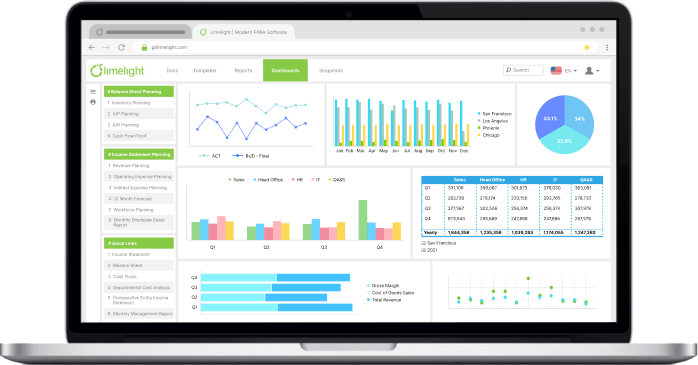Key Takeaways
- FP&A (Financial Planning and Analysis) encompasses reporting, budgeting, forecasting, and financial modeling to support manufacturing business health and decision-making.
- Cloud FP&A software eliminates human errors by integrating with ERPs to provide a single version of financial data across all teams.
- Manufacturing production capacity can increase by 35% according to Deloitte when organizations implement performance predictability through improved FP&A processes.
- Automated budgeting software accelerates monthly financial reporting and optimizes workforce planning by streamlining multi-stage approval processes for manufacturing budgets.
- Real-time data integration allows finance teams to analyze profit margins by product, geography, and channel while automating manual dashboard creation tasks.
- Limelight's FP&A solution helps manufacturers maximize profits and reduce costs through automated data gathering, AI tools, and deep analytical capabilities for strategic planning.
Many manufacturing firms don't realize just how much they're missing out on by forgoing dedicated FP&A solutions. In fact, many firms remain stuck at square 1 with the question 'what is FP&A?'?
Accuracy and efficiency are vital to success to manufacturing firms. Companies must maximize the profitability and ensure they maintain a strong debt to equity ratio and positive overall financial health. To do so, manufacturers require budgeting and planning software that can manage both financial and operational information and give executives the confidence they need to make data-backed decisions.
While other areas of manufacturing have changed or grown exponentially, the financial planning function has largely relied on static spreadsheets in Excel and other ad hoc solutions; many manufacturers remain unaware of the tremendous benefits of Cloud FP&A technology. According to Deloitte, organizations that take action to improve performance predictability can see production capacity gains by as much as 35%. Performance predictability involves mastering the basics of planning, forecasting and budgeting, through streamlined and standardized automation of financial processes.
Here are the top 5 benefits manufacturers can expect from Cloud FP&A software, and how they can leverage its power to better plan, manage, and control outcomes. But first, let's start with the basics: what is FP&A?
What is FP&A?
Financial planning and analysis (FP&A) focuses on activities that support a business’ financial health, including reporting and analysis, planning and budgeting, forecasting, and financial modeling. FP&A software delivers a wide range of data-driven insights that can support better decision-making and align business progress with organizational goals. Manufacturers can use FP&A software to speed up their most time-consuming processes and allow their teams to focus on analyzing company performance.
FP&A software is developed by FP&A teams and FP&A analysts with decades of experience in financial reporting. This means they know the issues that your team and organization - and know how to implement long-term solutions to them. Your financial statements contain insights and troves of data that can be leveraged by your financial analysts to great benefit. But first, you need the proper tools in place to access the data and insights. That's where FP&A solutions come in. FP&A comprises a central part of healthy business performance management.
1. Eliminate Inaccuracies
As your manufacturing company grows, so too will your budgets, and with it the complexity in process and risk of data inaccuracy from human errors. An automated and integrated FP&A solution eliminates potential human errors and allows managers to avoid working with outdated data. The integration with ERPs gives users a single version of financial data, ensuring that all teams are working with the same set of numbers to reduce errors. Using this technology, manufacturers can then develop complex calculations for standard costs across all their product lines, using accurate data they can trust.
2. Drive Greater Efficiency Across Your Organization
Budgeting and planning software accelerates and improves a manufacturer’s monthly financial reporting, along with operating and capital expenditure planning. For example, manufacturers can automate the calculation of production costs based on the most recent price of materials. Managers gain greater visibility into company expenses, allowing them to easily track costs and monitor overspending. This drives better predictability and utilization of resources and increases facility production while reducing operating expenses.
Automation can also optimize workforce planning by speeding up approvals. Manufacturing budgets often have many sign-off stages, which slows down production if not completed in a timely manner. Budgeting and planning software ensures approvals move smoothly with the correct stakeholders approving of budget plans.
3. Uncover New Insights
Many manufacturing executives require access to real-time data to see the current status of the business, but also to uncover new opportunities. Typically, finance teams spend days of manual effort creating dashboards for managers. Automating these manual tasks frees up more time to work on strategic projects with management and sales.
With FP&A software, manufacturers can model personnel and production costs effectively and efficiently. Reporting on and analyzing cost variances and other key metrics, such as inventory turns, COGS, and average prices are streamlined on an FP&A solution. Data is loaded from the ERP to reports, allowing teams to slice and dice their data as they see fit. Finance teams can analyze profit margins by product, geography, channel, and other dimensions, using the quick report creation made possible with FP&A software.
4. Gain Complete Visibility into Budgeting, Planning and Reporting
Finance teams in manufacturing companies often deal with preparing production budgets, direct materials budgets, direct labor budgets, and manufacturing overhead budgets. Automation makes this process smoother and more efficient, connecting data from disparate sources and making it available in real-time.
Manufacturers can track materials, vendors, and the amount of materials needed for production in budgeting and planning software. Teams access up-to-the-minute numbers from their general ledger and can use them in budgets, forecasts, and reports. Making effective decisions on new products or equipment is also easier with an on-demand view of cash flow.
5. Plan for All Outcomes with Flexible Reporting Options
FP&A software allows easy access to real-time insights so managers can develop data-driven business strategies for any scenario. The technology can optimize supply chains while reducing production costs. Manufacturing companies can accurately forecast and plan for multiple scenarios and maintain the right margins. Teams can also quickly plan for new and existing employee expenses, including direct and indirect labor costs, overhead, and overtime. Automation allows finance professionals to easily analyze and model merit increases, payroll costs, and compensation across departments.
Even simple changes such as a budget increase can be implemented into the system in just a few clicks. The software automatically calculates rates in real-time without manual effort, thus showing the potential impact immediately. Teams can shave weeks off the time that would be required to manually complete that process, which can then be used to further analyze and plan for multiple scenarios.
Modern Budgeting and Planning Software for Manufacturing Companies
Best-performing organizations fuse their financials and operations of the business together. Cloud FP&A technology enables manufacturers to manage complexities from a central platform, thus optimizing performance across the organization. Turn your team of FP&A professionals into a business unit that can produce real value for the entire organization. Craft strategic plans using FP&A tools like artificial intelligence, automated data gathering, deep analytical tools, and more.
Manufacturers manually planning with spreadsheets in Excel often manage dissimilar planning processes, needing to spend time on data entry from a variety of sources, or else consolidate complex data from multiple departments, increasing the risk of errors. A budgeting and planning software can help manufacturers drive greater efficiency while ensuring accuracy in all their processes. FP&A software leverages automation to integrate all data sources, provide real-time data from those sources into budgets, financial forecasts, and reports (like income statements), and ultimately allows managers to spot trends and uncover actionable insights. Analyze profit and loss (P&L) statements, historical data, and other key financial data using a leading FP&A platform, revealing critical insights that can inform strategic decision making.
To learn more about our modern FP&A solution and how it can help your company maximize profits and reduce costs, check out our FP&A for Manufacturing page.






